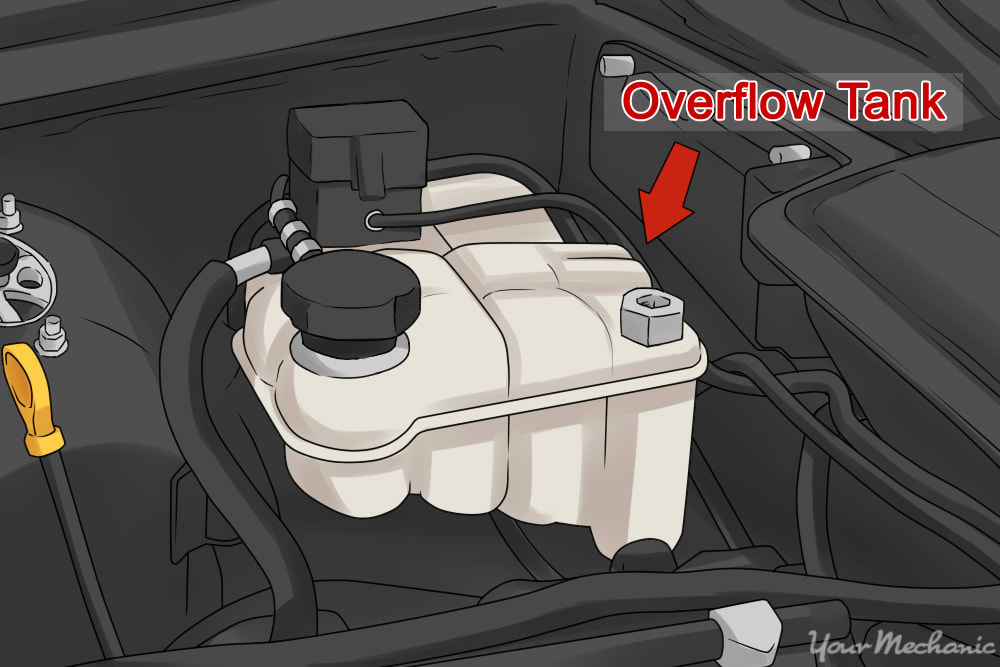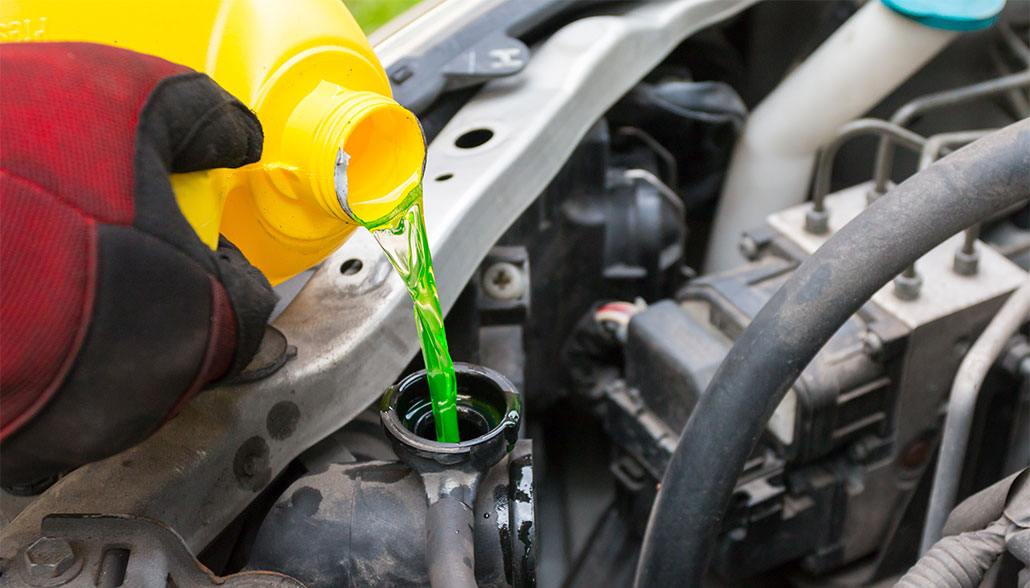Adding coolant to your car is essential for keeping the engine from overheating. But where exactly do you add it?
Should it go into the radiator or the reservoir? Understanding where to add coolant can be confusing for many car owners. The radiator and reservoir both play crucial roles in your vehicle’s cooling system. Adding coolant to the wrong place can lead to issues down the road.
In this blog post, we will clarify the difference between the radiator and the reservoir. We will guide you on where to add coolant to ensure your car runs smoothly and stays cool. Whether you’re a seasoned driver or a new car owner, this guide will help you maintain your vehicle’s cooling system effectively.

Credit: www.dummies.com
Introduction To Coolant Systems
Understanding your car’s coolant system is crucial for its health. Coolant, or antifreeze, keeps your engine from overheating. It helps in maintaining an optimal temperature. Knowing where to add coolant can save you from costly repairs.
Importance Of Coolant
Coolant plays a vital role in your vehicle’s performance. It absorbs heat from the engine and releases it through the radiator. This process prevents the engine from overheating. Overheated engines can seize up and fail.
Coolant also protects the engine from freezing in cold weather. It ensures smooth operation in all climates. It reduces wear on engine components. This extends your vehicle’s life.
Components Of A Coolant System
The coolant system has several key components:
- Radiator: Transfers heat from the coolant to the air.
- Water Pump: Circulates coolant through the engine and radiator.
- Thermostat: Regulates the engine temperature by controlling coolant flow.
- Coolant Reservoir: Stores excess coolant and maintains pressure.
- Hoses: Transport coolant between the engine, radiator, and reservoir.
Each part works together to keep your engine at the right temperature. A well-maintained coolant system prevents engine damage.
Radiator Vs. Reservoir
Understanding the difference between the radiator and the reservoir is essential for car maintenance. Both parts play crucial roles in keeping your engine cool. Knowing where to add coolant helps prevent overheating and engine damage.
Function Of The Radiator
The radiator is the main component of the cooling system. It helps dissipate heat from the engine. Coolant flows through the radiator, cooling down as it passes through. The radiator has metal fins that increase surface area for better heat dissipation. This process keeps the engine at a safe operating temperature.
Role Of The Reservoir
The reservoir, also known as the overflow tank, stores excess coolant. When the engine heats up, coolant expands and flows into the reservoir. As the engine cools, the coolant gets sucked back into the radiator. This helps maintain proper coolant levels and prevents air from entering the system. Always check the reservoir level to ensure there’s enough coolant for your engine.
When To Add Coolant To The Radiator
Add coolant to the reservoir, not directly to the radiator. The reservoir allows for proper coolant levels and pressure. Always check the coolant level when the engine is cold.
Adding coolant to the radiator is crucial for your car’s engine health. The coolant keeps the engine from overheating and freezing. Knowing when to add coolant can save you from costly repairs. Let’s dive into the signs of low coolant and the steps to add coolant to the radiator.Signs Of Low Coolant
Several signs can indicate low coolant levels in your car:- Engine Overheating: The temperature gauge rises above normal.
- Coolant Warning Light: This light appears on your dashboard.
- Low Coolant Level: The reservoir level is below the minimum mark.
- Heater Not Working: Your car’s heater blows cold air.
- Visible Leaks: Coolant puddles under your vehicle.
Steps To Add Coolant To Radiator
Adding coolant to your radiator is a simple task. Follow these steps for a safe and effective process:- Turn Off the Engine: Ensure the engine is cool before opening the radiator cap.
- Locate the Radiator Cap: Find the cap on top of the radiator.
- Open the Radiator Cap: Carefully twist the cap to release pressure.
- Check Coolant Level: Look inside the radiator to see the coolant level.
- Add Coolant: Pour coolant until it reaches the top of the radiator neck.
- Close Radiator Cap: Securely tighten the cap back on.
- Check Reservoir: Ensure the coolant level in the reservoir is between the ‘Min’ and ‘Max’ marks.
When To Add Coolant To The Reservoir
Understanding when to add coolant to the reservoir is crucial for your car’s health. The coolant keeps your engine from overheating and ensures it runs smoothly. Knowing the right time to add coolant can save you from costly repairs and breakdowns.
Indicators For Adding Coolant
Several signs indicate when it’s time to add coolant to the reservoir. Here are some key indicators:
- Temperature Gauge: If the gauge shows a higher temperature than usual, check your coolant level.
- Warning Lights: The dashboard may have a coolant light that turns on when levels are low.
- Visible Coolant Level: Check the reservoir; if the coolant is below the minimum line, it’s time to add more.
- Overheating: If your engine overheats, you might need more coolant.
Procedure For Adding Coolant To Reservoir
Follow these steps to add coolant to your car’s reservoir:
- Park your car on a level surface and let the engine cool down completely.
- Locate the coolant reservoir. It is usually a translucent plastic tank near the radiator.
- Check the coolant level by looking at the markings on the side of the reservoir.
- If the level is below the minimum mark, remove the reservoir cap carefully.
- Slowly pour the coolant into the reservoir until it reaches the maximum mark. Use a mixture of 50% coolant and 50% water unless your vehicle manual specifies otherwise.
- Replace the cap securely and start the engine. Let it run for a few minutes to circulate the coolant.
- Turn off the engine and recheck the coolant level. Add more if necessary.
Properly maintaining your car’s coolant levels is essential. It ensures your engine stays cool and runs efficiently.
Common Mistakes To Avoid
Maintaining your car’s coolant system is vital. Mistakes can lead to severe engine damage. Avoid these common errors to keep your vehicle running smoothly.
Overfilling The System
Overfilling the coolant system is a common mistake. Many think adding more coolant is better. This is incorrect. Overfilling can cause high pressure in the system. This may lead to leaks or even a blown head gasket.
To avoid this, always check the coolant level when the engine is cold. Use the markers on the reservoir. These markers show the minimum and maximum levels. Never exceed the maximum level.
Mixing Different Coolants
Mixing different types of coolant is another frequent error. Not all coolants are compatible. Mixing them can cause chemical reactions. These reactions can clog your radiator and harm your engine.
To prevent this, use the coolant recommended by your car’s manufacturer. Check your vehicle’s manual if unsure. Always use the same type of coolant to refill the system.
Here is a simple table for quick reference:
| Action | Correct Practice |
|---|---|
| Filling Coolant | Keep between min and max levels |
| Mixing Coolant | Use the same type of coolant |
Expert Tips For Maintaining Coolant Levels
Maintaining the right coolant levels in your vehicle is crucial. It ensures your engine stays cool and runs smoothly. Here are some expert tips to help you keep your coolant levels in check.
Regular Maintenance
Regular maintenance is key to keeping your coolant system in good shape. Check your coolant levels at least once a month. This simple step can prevent major engine problems down the road.
Look at the markings on the coolant reservoir. The levels should be between the ‘MIN’ and ‘MAX’ marks. If the level is low, add more coolant. It’s best to do this when the engine is cold. This avoids any risk of burns from hot coolant.
Using The Right Type Of Coolant
Using the right type of coolant is essential. There are different types of coolants for different vehicles. Refer to your vehicle’s manual to know which type you need.
Here’s a quick guide:
| Vehicle Type | Recommended Coolant |
|---|---|
| Passenger Cars | Ethylene Glycol-based Coolant |
| Heavy Duty Trucks | Propylene Glycol-based Coolant |
| Electric Cars | Silicate-Free Coolant |
Mix the coolant with distilled water if required. The usual ratio is 50% coolant and 50% water. This ensures the mixture works effectively.
Following these expert tips can help you maintain your coolant levels easily. This keeps your engine running smoothly and prevents overheating.
Troubleshooting Coolant Issues
Coolant issues can cause engine problems. It’s vital to know how to identify and fix them. This can prevent costly repairs. Below, we’ll explore common issues and solutions.
Identifying Leaks
Leaks can reduce coolant levels. This causes overheating. Check under the car for puddles. Look for wet spots around the engine. Inspect hoses for cracks. Any of these signs can indicate a leak.
Also, check the radiator. Look for rust or corrosion. This can cause leaks too. A pressure test can help find hidden leaks.
Addressing Overheating
Overheating can damage your engine. First, check the coolant level. Low levels can cause overheating. Add coolant to the reservoir if needed. The radiator should stay full.
Next, check the thermostat. A stuck thermostat can cause overheating. Replace it if necessary. Also, check the radiator cap. A bad cap can cause pressure issues. This leads to overheating.
Finally, inspect the water pump. A faulty pump can’t circulate coolant. Replace it if it’s broken. Ensuring proper coolant flow will prevent overheating.

Credit: www.yourmechanic.com

Credit: natrad.com.au
Frequently Asked Questions
Can You Add Coolant Directly To The Radiator?
Yes, you can add coolant directly to the radiator if it’s low. Ensure the engine is cool.
What Is The Purpose Of The Coolant Reservoir?
The coolant reservoir stores extra coolant. It helps maintain the proper coolant level in the system.
Should The Engine Be Hot Or Cold When Adding Coolant?
The engine should be cold. Adding coolant to a hot engine can cause burns and damage.
How Often Should You Check Coolant Levels?
Check coolant levels at least once a month. Regular checks prevent overheating and engine damage.
What Are The Signs Of Low Coolant Levels?
Signs include engine overheating, a warning light, and poor heater performance. Check coolant if you notice these.
Conclusion
To summarize, adding coolant to your radiator or reservoir is essential. Always check your vehicle’s manual first. Understanding where to add coolant prevents engine issues. Keep your coolant levels steady for smooth driving. Regular checks and maintenance are key. Your car will thank you for it.
Ensure you use the correct type of coolant. Stay safe and keep your engine cool. Happy driving!

















